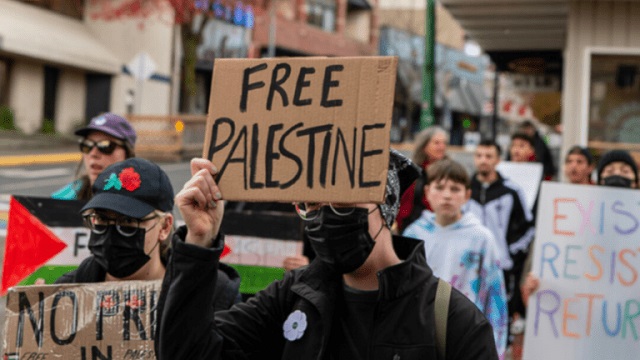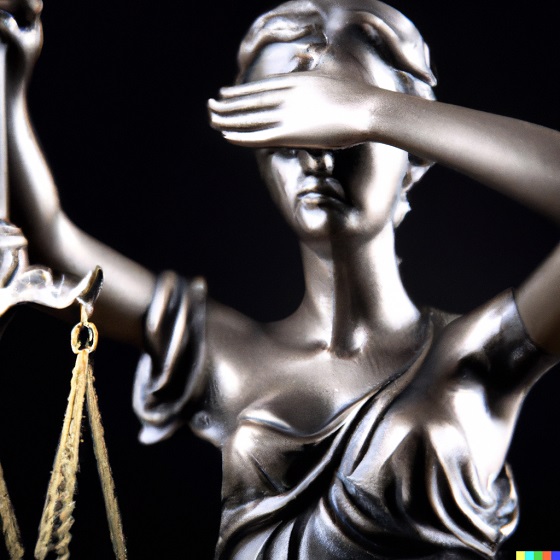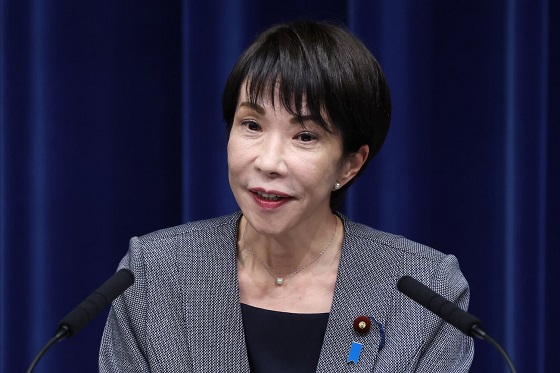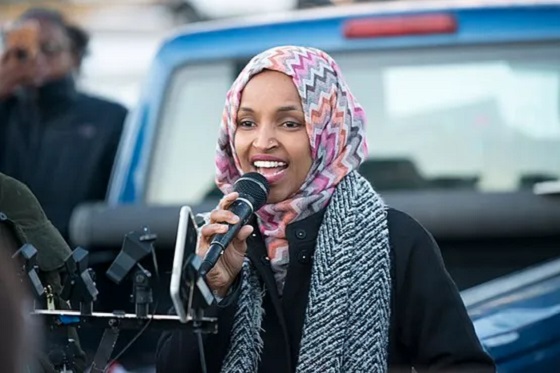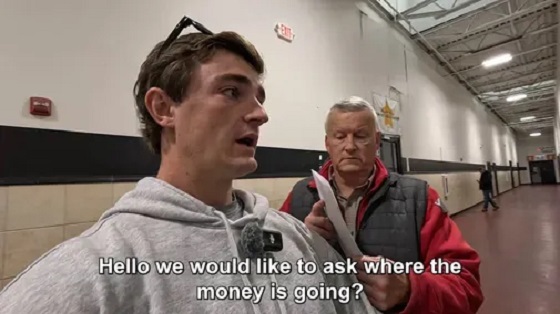From the MacDonald Laurier Institute
By Joe Adam George
Regardless of how one feels about free speech, pro-Hamas protests have revealed some hidden, uncomfortable truths about many of our fellow Canadians
Rallies blocking traffic at major intersections. Protestors intimidating businesses and community centres. Radicalized student unions paralyzing college and university campuses. Hateful and incendiary messages dominating social media. Pro-Palestine agitators ripping down posters of hostages and waving the flags of banned terrorist organizations like Hamas and Taliban.
These sustained public acts of malice – specifically targeting Israel and the Jewish community –have become the new norm in Canada in the aftermath of the Oct. 7 terrorist attacks that Hamas, a listed foreign terrorist organization in Canada, committed against 1,400 unsuspecting civilians in Israel, in addition to taking over 240 hostages. Calls for a global “Day of Jihad” and similar rabble-rousing by Hamas sympathizers and pro-Palestine groups have only added fuel to the raging fire.
Invigorated by the brutal events of that fateful day, a populist, mostly Muslim Arab faction, has found a “solidarity ally” in the radical left – a rather odd symbiosis given these groups have very little in common (barring of course, their mutual sadistic hatred of Jews and desire to see the annihilation of Israel). Their oft-frightful vituperations, which include ostensible acts of glorifying terrorism, antisemitism, and intimidation of Jews (a protected minority community in Canada) has left many mild-mannered Canadians aghast, drawing parallels with Kristallnacht (a wave of coordinated pogroms that took place 85 years ago in Nazi Germany and its annexed territories).
From leftist students cheering for “intifada” (violent resistance) and branding Hamas terrorists as “martyrs”, to multiple instances of arson, shootings, assault, death threats and calls for the boycotting of Jewish-owned businesses, the last few weeks have been a living nightmare for Canadian Jews as they continue to be inundated with vitriol in the streets and on social media.
Much ink has been spilled debating whether these acts and their perpetrators are in violation of Canada’s hate speech and terrorism laws, considering that Canadians (Jewish and non-Jewish alike) are quickly becoming accustomed to seeing blatant expressions of antisemitism and hatred on a daily basis.
Do flying Hamas and Taliban flags cross a line of criminality into “supporting” a listed terrorist entity? Can the infamous “machine gun earrings lady” be prosecuted for glorifying and promoting terrorism for publicly singing the praises of the Hamas terrorists? Should the former Carleton University economics professor who tweeted that Israelis brought the horrific events of Oct. 7 “on themselves” be charged for hate speech? Can the actions of the protestors who targeted and harassed Jewish coffee shops and delis in Toronto be construed as the “public incitement of hatred”? Could those who chant the unambiguously genocidal slogan “From the river to the sea, Palestine will be free” be viewed as “advocating genocide”?
The answer to all these questions is a likely “no”.
Josh DeHaas, counsel with the Canadian Constitution Foundation, told me in an interview last week that Canada’s existing hate speech laws are poorly understood by many. Moreover, he pointed out that the recent explosion of vitriol caused by the Israel-Hamas conflict is “a new phenomenon” not just for regular Canadians, but also for the law enforcement agencies grappling with the unprecedented wave of vitriol.
“They have their work cut out for them because hatred is a notoriously difficult concept to define,” DeHaas said. “We know the bar for criminal hate speech in Canada is very high but, despite multiple court decisions discussing hate speech, we still don’t know exactly how high”.
“If you look at Twitter, you’ll quickly see that what counts as hateful is in the eye of the beholder. Feminists who advocate against wearing hijabs are often accused of engaging in hateful conduct against Muslims; but, to those feminists, advocating that women must or should wear hijabs is hateful towards women,” DeHaas explained. “Another example comes from the debate over whether transgender women should be in certain spaces—both sides accuse the other side regularly of engaging in hate speech. It’s unlikely this is illegal in Canada but it’s hard for regular people to know.”
“This difficulty with defining hatred leads to a chilling effect, since people fearing they will cross the line into criminality are worried about saying anything controversial. And that’s a huge problem for freedom of expression, since the purpose of freedom of expression is to allow for controversial ideas to be debated, and we can’t debate these things if people are afraid to speak,” he added.
“The subjective nature of what counts as hatred is one of the reasons why we at the Canadian Constitution Foundation are wary of legal restrictions on speech,” explained DeHaas. “That said, the Supreme Court of Canada has stated that hatred can be outlawed if it’s limited to those extreme manifestations of the emotion as described by the words ‘detestation’ and ‘vilification’.”
DeHaas cited the example of the 2013 R v Whatcott case, wherein then-Justice Marshall Rothstein of the Supreme Court offered some guidance on when speech will cross the line from merely offensive or humiliating into something that warrants placing a “reasonable limit” on freedom of expression. Criminal hate speech, wrote Justice Rothstein in the decision, includes “representations that expose a target group to detestation tend to inspire enmity and extreme ill-will against them, which goes beyond mere disdain or dislike.”
Justice Rothstein added that such outlawed speech may be identified by looking for the “hallmarks of hatred.” This may include “vilify(ing) the targeted group by blaming its members for the current problems in society, alleging that they are a powerful menace, arguing that they are carrying out secret conspiracies to gain global control or plotting to destroy western civilizations, saying that they are a parasitic race, liars, cheats, criminals or thugs, genetically inferior, lesser beasts, or sub-human filth.”
“‘Hatred’ is objectively defined so it is not supposed to matter whether an individual found the speech or tweet hateful,” DeHaas explained. “What is supposed to matter is whether a reasonable person, aware of the context and circumstances surrounding the expression, would view it as exposing the protected group – for example, Jews and people of Israeli origin – to hatred by others.”
“According to the Court, hate speech laws aren’t meant to censor; they’re meant to prevent harm that can result from exposing a group to hatred, which, in the Court’s view, can lead to exclusion of members of the group from society or even worse consequences like the Holocaust,” he added. “However, it’s still very difficult to know exactly where the line between merely offensive speech, which is legal, and speech that counts as the most extreme forms of vilification and detestation, which can land a person in prison.”
While Section 319 (2) of the Criminal Code is the main hate speech provision outlawing “wilful promotion of hatred”, charges and convictions under this section are relatively rare. Section 319 (2.1) is a new and untested provision specifically targeting antisemitism. Passed by Parliament just last year, it prohibits any individual or group from “communicating statements, other than in private conversation, [that] wilfully promotes antisemitism by condoning, denying or downplaying the Holocaust”. Both offences carry a two-year term of imprisonment.
Another relevant statute, Section 318 (1), carries a five-year prison sentence for anyone “advocating or promoting genocide”, defined as: “committing with intent to destroy in whole or in part any identifiable group [by] killing members of the group or deliberately inflicting on the group conditions of life calculated to bring about its physical destruction”.
DeHaas said the comments made by Montreal-based Imam Adil Charkaoui to a crowd on Oct. 28, which have been translated online as “Allah, destroy the arrogant Zionists…Allah, count every one of them, and kill them all, and do not exempt even one of them” may have breached Section 318 (1). That will likely depend on whether “Zionists” counts as a section of the public distinguished by race, religion or national or ethnic origin, he added.
This stated, DeHaas also cautioned that individuals have rarely been charged or convicted under any of the three hate crime statutes mentioned above as they all have high legal bars for prosecutors to prove criminal intent beyond a reasonable doubt. Besides, these offences are also unusual in the sense that they require the Attorney General of the province where the alleged offense took place to sign off before prosecution. (DeHaas noted that the police, not the Crown, lay charges in the case of most criminal offenses).
In addition to these provisions, any criminal offence that is motivated by hatred (e.g., assault, criminal harassment) can have the aggravated hate charge applied, possibly leading to a harsher sentence in the case of a conviction. For example, Calgary police charged a protester last week with “uttering threats” against two Jewish community organizations. Toronto Police, meanwhile, have pressed charges against a man who allegedly assaulted a person affixing pro-Israel posters to a utility pole. Both men, if convicted, could receive a tougher sentence if found to have been motivated by hatred.
Some lawyers have raised the possibility that those who publicly voice support for Hamas could be charged under Section 83 of the Criminal Code, which prohibits promoting terrorist activity. For example, some have suggested that the “machine gun earrings lady” (identified in media reports as Essra Karam) can be charged under Section 83 for saying “I support Hamas” and calling Hamas terrorists “true fighters” in an interview with The Rebel’s David Menzies.
DeHaas, who stresses that he is not an expert in terrorism laws, is nonetheless skeptical that merely stating support for a listed terrorist group, as this woman has clearly done, would violate the terrorism provisions of the Criminal Code.
“However, I do think it would be appropriate for authorities to investigate whether she is supporting Hamas in a more material sense by fundraising or recruiting for Hamas at the rally, because that is clearly illegal, and if she is not a Canadian citizen, it is possible that she could be inadmissible to Canada under the Immigration and Refugee Protection Act”, DeHaas added.
Dan Stanton, Director of the National Security Program at the University of Ottawa and a former Canadian Security Intelligence Service (CSIS) manager, agreed with DeHaas’ assessment and on that same note, expressed bewilderment at how dangerous and unreformed jihadists like Montreal’s Charkaoui could acquire full Canadian citizenship and walk around freely spewing hate; especially given his criminal track record, which includes stints in prison for alleged al-Qaeda ties and promoting radical Islam with the goal of exhorting people to go overseas to join terror groups.
Stanton also raised a worrying point – the pro-Hamas rallies and demonstrations are likely to have radicalized and galvanized certain left-wing and Islamic extremists, which could potentially pose a serious threat to the national security of Canada and its allies, should these individuals conduct lone-wolf attacks, fundraise, recruit or travel abroad to participate in overseas conflicts.
Since its vicious attack on Israel, Hamas has made its aspirations to create a “global Islamic caliphate” quite clear. It is little wonder why Hamas is viewed as “the new ISIS” – an observation FBI Director Christopher Wray made during his testimony before the U.S. Senate Homeland Security and Governmental Affairs Committee late last month, telling the Committee, “We assess that the actions of Hamas and its allies will serve as an inspiration, the likes of which we haven’t seen since ISIS launched its so-called caliphate several years ago”.
This warning should be taken seriously by the Trudeau government as, unlike in Europe, where terror attacks have generally been carried out by refugees or illegal immigrants, Canada’s most serious threats are likely to come from radicalized homegrown extremists. However, Phil Gurski, a former senior strategic terrorism analyst with CSIS, said the Trudeau government’s inept handling of the conflict and general apathy towards its imperiled Jewish community proves it hasn’t learned from its recent experiences with Chinese and (alleged) Indian interference and, instead, continues to prioritize vote-bank politics over Canada’s national security and longstanding ties with Israel.
So, what does all this mean for Canada’s Jews and other Canadians? Do they continue to put up with these despicable acts of vitriol and violence and wait until someone is grievously hurt or killed like the 69-year-old Jewish man in Los Angeles?
Both Gurski and Stanton remarked that the top priority for law enforcement agencies and all levels of government should be to reassure Jewish communities by taking meaningful preventive measures to ensure their safety and security. They added that CSIS is likely to be tracking suspicious individuals and extremists who were already under the scanner, and also investigating for clues that indicate any fundraising or recruitment activities being conducted by Hamas, Hezbollah and ISIS sympathizers in Canada.
At a campaign reception in Minnesota last week, U.S. President Joe Biden said rather profoundly: “You know, about every six, eight generations, we go through a phenomenal change. What happens in the next two, three, four years is going to determine what the next four or five decades are going to look like.”
Regardless of how one feels about free speech and the hate crime statutes, the pro-Hamas protests have revealed some hidden, uncomfortable truths about many of our fellow Canadians – their blind hatred of Jews and contempt for law and order, historical facts (pertaining to the Israel-Palestine conflict), and western values and principles. Undeniably, the ancient evil of antisemitism poses an existential threat to Canadian values, unity and security but we can remain optimistic that these violent protests would serve as the inflection point Canada desperately needs to dismantle such deep-rooted, hideous ideologies and the systems that perpetuate them; which would determine if its long-term future remains in the civilized world or with those who lionize the women-raping and baby-killing barbarians of Hamas.
Joe Adam George is a former foreign policy and national security research intern with the Washington, D.C.-based policy think tank, Hudson Institute, and a communications strategist.
